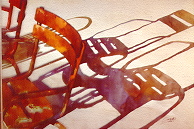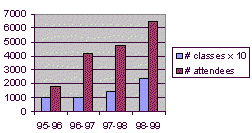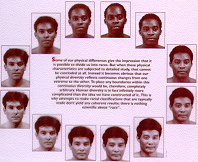
Issue No. 32
April 1999
水色印象
Impressions of Light and Shadow
An exhibition of watercolors by Zhinan Jiang will open on 22 April in the Library Gallery. Jiang was trained in dyeing arts at the Central College of Arts and Crafts in Beijing. He began exhibiting his watercolor paintings in 1990. He is now regarded as one of the outstanding watercolor artists in China. “Light is very significant in Jiang’s painting” noted Jiang’s teacher, Professor Dakai Du. “It is not only a medium, but also a goal.”

Chairs in Luxembourg Gardens, Paris
蔣智南對於光與影的處理十分敏感與生動。杜大愷教授稱讚他的技巧是 “手與心相合,影與情相融”。
COLLECTION SPOTLIGHT: Women’s Studies
Women’s studies is a cross disciplinary subject that includes materials ranging from “women in religion” to “women soldiers”(LC classifications BL 458 to U51). A continually growing area of scholarship, women from every place on the planet have studied, analyzed and published on their history, present position, and future.
The HKUST Library maintains a sizable collection of reference resources and two databases, one in Chinese and the other in English, specifically devoted to Women’s Studies. The Chinese database, “婦女研究(1980-1994)”, includes full-text Chinese newspaper and magazine articles covering women’s movements, history and other women’s issues in China and the world. The one in English, “Contemporary Women’s Issues“, covers over 600 sources published around the world. It focuses on health, human rights, the work place, and legal status.
The majority of the Library’s collection on women’s studies are filed under women and feminism (LC classes HQ1100 – HQ2000). There are over 1000 items ranging from the practical “婦女生活手冊” (HQ1781 .F8 1998) to the more theoretical “Mappings: feminism and the cultural geographies of encounter” (HQ1190 .F77 1998). The collection includes works on feminist theory by noted philosopher Sandra Harding, both older items such as “Feminism and methodology : social science issues” (H61 .F38 1987) and more recent ones like “Is science multicultural : postcolonialisms, feminism, and epistemologies” (Q175.5 .H39 1998). You will also find in our collection works by the renowned author 李銀河, who is a pioneer in exploring womens issues in China. She has written several noteworthy books, including “中國女性的性與愛” (HQ29 .L528 1996)
The Library also subscribes to over 20 different journals in this subject area, and we collect media materials on different aspects of women and their lives. Of special note is “Women of the world” (Media HQ1399 .W6 1989), a 7 part series on women’s lives in twenty different countries; and “Half the sky” (Media HQ1767 .H35 1996) which explores the role of women in China today. There are also works on women’s careers like “Women in computing” (Media HD6073.C6522 U58 1998) and “Women in engineering” (Media TA157 .W653 1993).
Search the Library catalog for the words women, feminism, family, marriage, sex, gender, and even children to find items of interest to you.
WEB: China Studies 中國學
http://library.hkust.edu.hk/res/pf/china/china-home.html
長久以來,為了能協助讀者查尋有關中國的各種資料, 同時也希望能促進讀者對中國文化的了解和興趣, 圖書館一直計劃推出一個有關中國文化的簡介。 經過一年多的討論與修改,這個網頁終於在三月初推出了。
由於中國文化涵蓋題材廣泛,幾經考慮,我們作了以下限定: 主題方面目前僅限於文學、藝術、歷史、哲學與宗教, 和科學與技術。內容方面,則祇介紹具有代表性的館藏與 精選的萬維網頁。本館資源的介紹分為三部分:參考書、 推薦著作及用以檢索本館目錄的相關主題詞。作品的取捨上, 我們的基本原則是:在學術著作方面,盡量選擇名學者的代表作, 或能全面反映該學科的論著及叢書;在文藝創作方面, 各別名家名著一概不列,只列有代表性的選集及叢書。 在組織上,則根據每個主題的特性而作出不同的安排。 舉例而言:譬如 “藝術” 的網頁分為”美術” 和 “表演藝術” 兩部分; “文學作品” 則以評論與創作來作區分; “歷史著作” 則按 “朝代” 列出。
我們希望這個簡介能對讀者有些許幫助,也希望讀者能 向我們提出意見,使我們能繼續地改善這個網頁的內容。
Don’t ‘Bookmark’ Library Resources, Please!
Please do not bookmark database and electronic journal web sites which you get to from the Library Resources pages of the Library web server (http://library.hkust.edu.hk/res/).
The Library subscribes to many electronic resources on the Web. To access them, you would visit the Library’s web server and select a link to a database or electronic journal.
Most of the time you won’t have to enter a username or password. The publisher has their server check the address of your computer and see if it is on the list of allowed addresses. That authorization is paid for by the Library.
Once you arrive at the publisher’s web site, you could add it to the bookmark list in your web browser. BUT we are asking you not to do that.
What’s Wrong With Bookmarking? When you use the link on the Library’s web page, this access is added to our usage statistics. When you go directly to the bookmarked site, the only way the Library would ever know is if the publisher provided usage statistics to us. And almost none of them do.
Why Should You Care? If no one uses the link on the Library’s web page, then it looks like no one is using the database. So when the time comes for the Library to renew the subscription, it may be very hard to justify the cost.
That’s Not Fair! We are always asking publishers to provide usage statistics with our subscriptions, but most have not developed a way to do this. To make the best spending decisions with a shrinking budget, we need as much usage information as we can get.
Every time you use the links on our Library Resources pages you help us collect this information. And every time you forget means that our statistics are incomplete, and contribute an invalid factor in our decisions.
MEDIA: Materials for the School of Business and Management
This is the first in a series describing some of the materials available in Media Resources for the different Schools and Divisions.
Business and Management: Most of the materials are in VHS format. They range from practical how-to aspects of management to more historical and theoretical works. The collection has practical business materials, for example, over one hundred titles on personnel management alone. Some are in series like 9 traits of highly successful work teams (Media HD66 .N554 1995) and Conquering team conflict (Media HD66 .C566 1997). The library has also collected case studies of individual companies, many from Harvard Business School, like Dansk Designs, Ltd (Media HD9616.D4 D367 1995 pt.1-2) and Decline of People Express (Media HE9803 .P46 D43 1989).
We have biographies and interviews with famous business people, like Stanley Ho or Richard Branson who are profiled in the 13 part series Tycoons (Media HF5386 .T936 1990). One can also watch videos on the history of industries likeTriumph of the nerds (Media HD9696 .C62 T75 1996) which is a 3 part series on the early days of the PC industry.
Economics: The Library maintains a collection to assist instructors and students in economics. Prominent among the collection is a 17 part series, Introductory economics (Media HB71 .I577 1996) and the 24 part series Principles of macroeconomics (Media HB 172.5 .P755 1991). We did not neglect works on economic development either. For example, one can view The competitive advantage of nations (Media HD3611 .C62 1993) and watch Michael Porter explain his theories about national competitive advantage as it is applied to industry.
SYSTEMS UPDATE: Web Catalog
We have made a lot of changes in the Web interface to the Library Online Catalog (http://ustlib.ust.hk/). Now that it is out of the test phase, we spent some time making it easier to use. The biggest change was to eliminate the initial screen, so that users can immediately start a search.
Now all the links to other library catalogs, to our Library’s information, and to the various help and feedback forms have been consolidated onto the primary interface screen. An updated online user guide can be found at http://library.hkust.edu.hk/res/guides/opac/
For the next step, our staff are working on translations for all the screen and button text, so that a more fully Chinese interface will be available.
Library Instruction – Achieving a Higher Ground!
Our instructional activities have experienced massive growth in recent years, especially for this academic year. From July 98 to March 99, the Library has offered 236 classes and orientations to 6442 students (a small percentage are staff). This represents a 65% increase in sessions and a 36% increase in attendees compared to last year’s figures.

INTERNET: Music Resources
The Internet provides many valuable resources for music lovers and researchers. Directories are good starting points for exploring the large number of music sites. For example, Worldwide Internet Music Resources at http://www.music.indiana.edu/music_resources/outline.html provides a comprehensive and well-organized directory on many topics in music. If you are a music researcher, you can try Internet Resources for Music Scholars at http://www.rism.harvard.edu/MusicLibrary/InternetResources.html. Classical music lovers should visit the Classical Music Department of the WWW Virtual Library at http://www.gprep.pvt.k12.md.us/classical and the Classical Music Web Ring at http://www.orchestranet.co.uk/ring.html.
Two databases provided by All-Media Guide at http://www.allmusic.com/ and http://allclassical.com/ are good reference tools for recorded music. The former focuses on Western popular music genres whereas the latter is for classical music. In these databases, you can find reviews and track information on albums, biographies on musicians and groups, a glossary and essays on musical styles, and much more.
For music of Hong Kong and China, you can search the directories on Yahoo Hong Kong at http://www.yahoo.com.hk/entertainment/music/ and the music page on Miningco.Com at http://chineseculture.miningco.com/. These directories provide links to both popular and traditional music genres.
You can also download music from the Internet. Several sound encoding formats have been developed which are changing the ways recorded music is distributed. The most popular are RealAudio (http://www.realaudio.com/) and MP3 (http://www.mp3.com/). The quality of MP3 has caused a lot of debate regarding copyright and publishing issues. For a good discussion of this, see the article Distributing Music Over the Internet at http://www.duke.edu/~bdk3/music.html.
All of Us Are Related;
Each of Us Is Unique
The Library is sponsoring an exhibit on “race” in the Library Gallery from 19 March to 16 April. This is an effort to support the Division of Social Science’s lecture and panel discussion on this topic, which was held on 23 March.
This thought-provoking exhibit consists of 18 prints, 3 introductory panels, and a film entitled “Six Billion Races”. Produced originally by a team of biological anthropologists at the University of Geneva in Switzerland, the exhibit was first shown at the Musee de l’Homme in Paris in 1992 under the title “Tous Parent, Tous Differents”. Professor Segall at Syracuse University translated the exhibition into English, and it is now touring the world.
Supported by recent scientific evidence, the exhibit claims that every person on earth is kin to every other because we all have the same ancestors. The exhibit begs the question: “If there is no such thing as ‘race’, why do we still have racism? As suggested by Dr. Kimberly Chang: “Given the unique history of racism in Hong Kong, as well as the current usage of the term “race” in political debates about Chinese identity and citizenship, this exhibit would find an apropos setting in Hong Kong at this time.”

The Illusion of Race
last modified 12 April 1999

